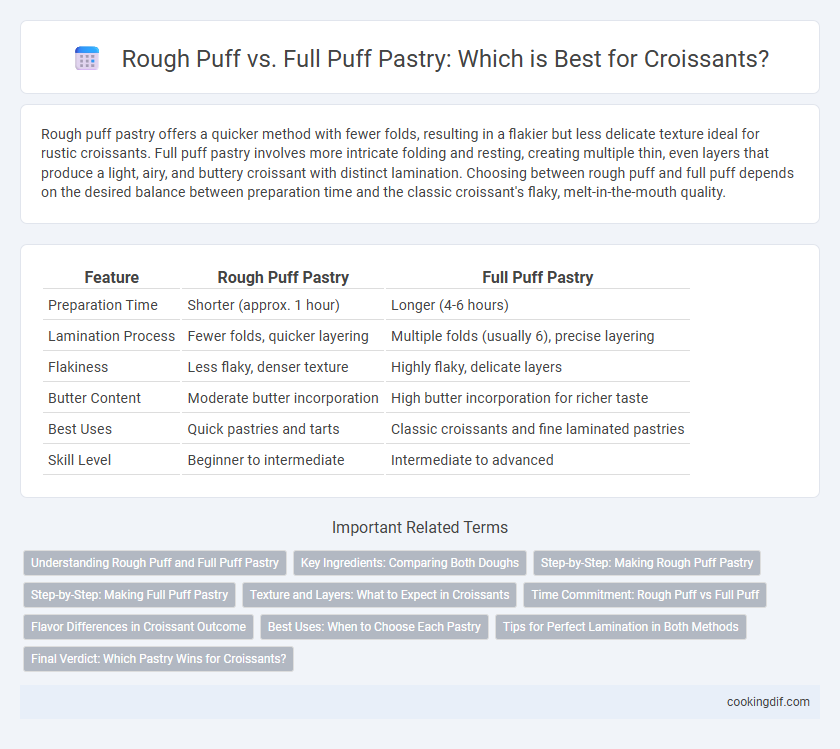Rough puff pastry offers a quicker method with fewer folds, resulting in a flakier but less delicate texture ideal for rustic croissants. Full puff pastry involves more intricate folding and resting, creating multiple thin, even layers that produce a light, airy, and buttery croissant with distinct lamination. Choosing between rough puff and full puff depends on the desired balance between preparation time and the classic croissant's flaky, melt-in-the-mouth quality.
Table of Comparison
| Feature | Rough Puff Pastry | Full Puff Pastry |
|---|---|---|
| Preparation Time | Shorter (approx. 1 hour) | Longer (4-6 hours) |
| Lamination Process | Fewer folds, quicker layering | Multiple folds (usually 6), precise layering |
| Flakiness | Less flaky, denser texture | Highly flaky, delicate layers |
| Butter Content | Moderate butter incorporation | High butter incorporation for richer taste |
| Best Uses | Quick pastries and tarts | Classic croissants and fine laminated pastries |
| Skill Level | Beginner to intermediate | Intermediate to advanced |
Understanding Rough Puff and Full Puff Pastry
Rough puff pastry combines butter and dough in uneven layers, creating a flaky texture suitable for quicker preparation and less delicate pastries. Full puff pastry undergoes extensive folding and rolling, producing hundreds of thin, even layers ideal for croissants with a light, airy crumb. Understanding the differences helps bakers choose the right technique to balance texture, flavor, and time investment.
Key Ingredients: Comparing Both Doughs
Rough puff pastry combines butter chunks with flour to create a flaky texture through fewer folds, resulting in quicker preparation and a slightly denser crumb. Full puff pastry involves multiple precise folds with thin layers of butter fully incorporated, producing a lighter, more delicate croissant with pronounced rise and air pockets. The key difference lies in butter distribution and lamination consistency, influencing flakiness and crumb structure in the final product.
Step-by-Step: Making Rough Puff Pastry
Rough puff pastry combines butter and dough through quick folds and rough layering, creating distinct flaky layers ideal for croissants with a less delicate texture than full puff. Begin by chilling cubed butter and folding it into the dough in uneven layers, then perform several folds and turns, chilling the dough between each step to maintain butter firmness. This faster method produces a tender, multi-layered croissant that balances flakiness and richness without the extended lamination needed for full puff pastry.
Step-by-Step: Making Full Puff Pastry
Full puff pastry requires precise steps including multiple folds and turns to create distinct, even layers that result in a flaky, delicate texture ideal for croissants. Begin with a well-chilled butter block encased in dough, perform a series of letter folds (usually three to four turns), resting the dough in the refrigerator between folds to maintain butter consistency. This method ensures optimal lamination, producing a light, airy rise and rich buttery flavor compared to the quicker rough puff technique.
Texture and Layers: What to Expect in Croissants
Rough puff pastry produces croissants with a flaky and slightly coarse texture, featuring distinct but fewer layers due to its quicker lamination process. Full puff pastry, on the other hand, creates croissants with a delicate, buttery crumb and numerous ultra-thin, crisp layers resulting from its multiple folds and resting periods. Expect rough puff croissants to be heartier and less intricate, while full puff croissants offer a light, airy structure with a signature melt-in-the-mouth quality.
Time Commitment: Rough Puff vs Full Puff
Rough puff pastry requires significantly less time commitment, typically taking around 2 hours, as it involves fewer folds and less resting time compared to full puff pastry. Full puff pastry demands a longer process, often 4 to 6 hours or more, due to multiple precise folds and extended chilling periods to achieve maximum flakiness and rise. This makes rough puff ideal for quicker croissant preparation, whereas full puff pastry is preferred for superior texture and buttery layers in traditional croissants.
Flavor Differences in Croissant Outcome
Rough puff pastry yields a croissant with a denser texture and a more buttery, slightly rustic flavor due to less lamination and fewer layers. Full puff pastry produces a lighter, flakier croissant characterized by distinct, crispy layers and a delicate buttery aroma that enhances the overall eating experience. The choice between rough puff and full puff directly influences the croissant's flavor complexity and mouthfeel, making full puff ideal for traditional, airy croissants.
Best Uses: When to Choose Each Pastry
Rough puff pastry, with its quicker preparation and flakier texture, is ideal for savory dishes and casual bakes like sausage rolls or pot pies where tenderness and a light crunch are desired. Full puff pastry, known for its delicate, evenly layered structure, excels in classic croissant-making and intricate desserts where a buttery rise and airy, crisp layers are essential. Choose rough puff for time-sensitive recipes and robust flavors, while full puff is best for traditional pastries demanding refined flakiness and an elegant finish.
Tips for Perfect Lamination in Both Methods
Achieving perfect lamination in both Rough Puff and Full Puff croissant dough requires maintaining consistent, cold butter layers to prevent melting and merging during folding. Use precise folding techniques--three to four folds for Rough Puff and six full turns for Full Puff--to create distinct, flaky layers. Keep the dough chilled between folds and avoid overworking to ensure optimal rise and a tender, airy texture in the final pastry.
Final Verdict: Which Pastry Wins for Croissants?
Rough puff pastry offers a quicker preparation with a lighter, flakier texture ideal for casual croissants, while full puff pastry delivers a more refined, buttery, and layered crumb crucial for traditional French croissants. The final verdict favors full puff pastry as the superior choice for croissants due to its precise lamination process, producing the classic rise and crispness essential to authentic croissants. Choosing full puff ensures optimal texture and flavor, meeting both professional baker standards and discerning customer expectations.
Rough Puff vs Full Puff for croissants Infographic

 cookingdif.com
cookingdif.com